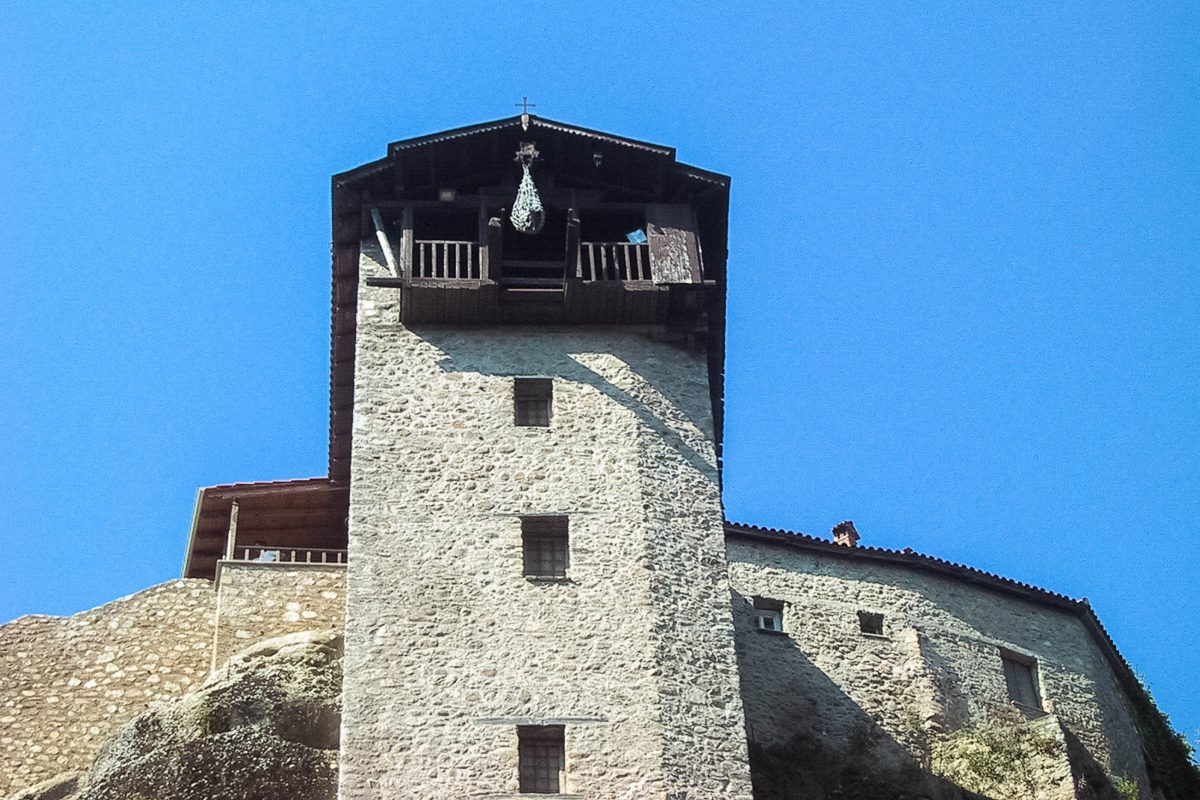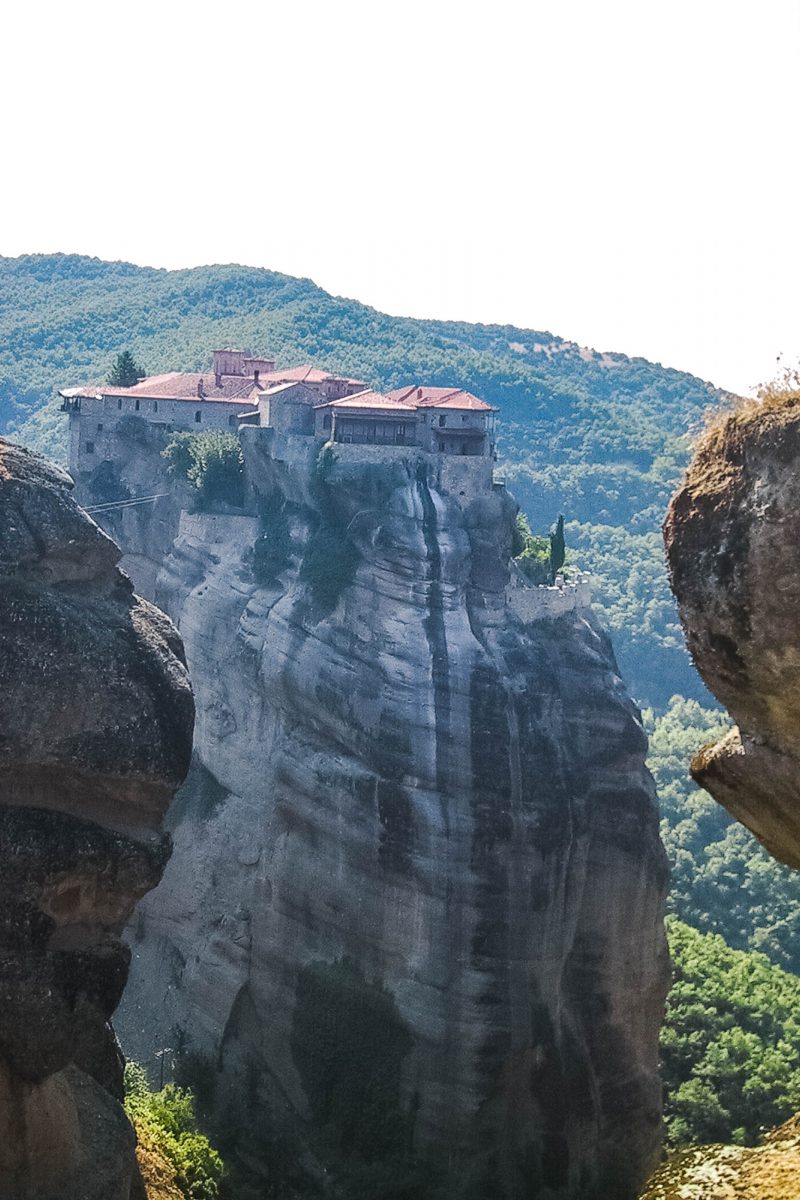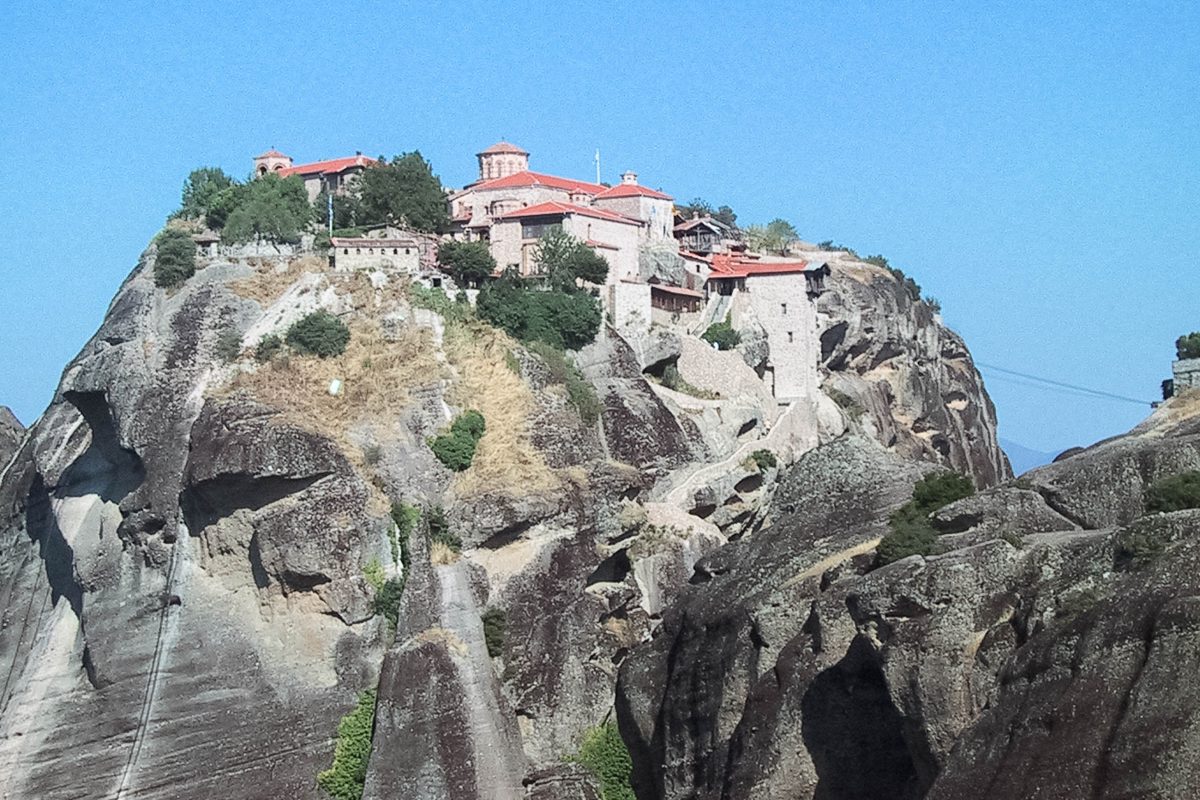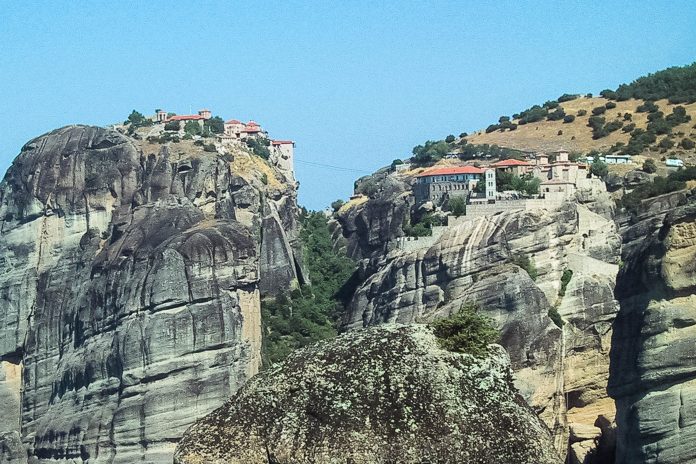Die „schwebenden Klöster“ auf den Meteora-Klippen zählen zu den beliebtesten Reisezielen Griechenlands. Neben den historisch wertvollen Anlagen ist auch die überwältigende Aussicht einen Besuch wert!
Mitten im Gebirge im Herzen des Landes ist eine der spektakulärsten Sehenswürdigkeiten Griechenlands zu finden, die auch auf unserer Liste der Top 10 Sehenswürdigkeiten von Griechenland steht. Die Meteora-Klöster, die auf den steil aufragenden Felsklippen balancieren, zählen seit 1988 zum Weltkulturerbe der UNESCO und gehören zu unseren 10 sehenswertesten Klöstern der Welt.
Inhaltsverzeichnis
BILDER: Meteora-Klöster
Im Morgennebel scheinen die Meteora-Klöster zu schweben, was ihnen auch ihren Namen verliehen hat: Meteore bedeutet „in die Höhe heben“. Abgesehen von den 24 Klöstern zählen die Meteora-Felsen zu den beliebtesten Kletterzielen Griechenlands. Im Jahr 2001 hat der Österreicher Felix Baumgartner, seit 2013 weltberühmt mit seinem Fallschirmsprung aus der Stratosphäre, einen Base Jump von einer der Klippen absolviert.
Geschichte der Meteora-Klöster

Die Meteora-Klöster entstanden aus Einsiedeleien in Felsspalten, die Überlieferungen zufolge bis auf das 10. Jahrhundert zurückgehen. Das erste Kloster namens Doúpiani stammt aus dem frühen 13. Jahrhundert, von ihm ist allerdings nur noch eine Kapelle erhalten, die jedoch nach wie vor genutzt und erhalten wird.
Die religiöse Blüte der Klöster erfolgte allerdings erst ab dem Jahr 1334. Damals flüchtete der Mönch Athanasius vor der türkischen Herrschaft aus der Mönchsrepublik Athos in die Meteora-Klöster. Er gründete das bis heute größte Kloster namens Metamórphosis und verfasste die ersten Regeln des Klosterlebens. Die Mönche in den Meteora-Klöstern lebten im zönobitischen System, das heißt besitzlos, in Gemeinschaft und von der Außenwelt abgeschnitten.
In den darauffolgenden Jahrzehnten wurden weitere Klöster errichtet, deren Gründer zum Großteil nicht mehr namentlich überliefert wurden. Aufgrund ihrer schweren Zugänglichkeit wurden die wohlhabenden Klöster nie geplündert oder überfallen und die Mönche konnten in aller Ruhe ihren Geschäften nachgehen.
Besichtigung und beste Reisezeit der Meteora-Klöster

Jene sechs Klöster, in denen bis heute Mönche und Nonnen leben, sind für Besucher zugänglich. Die Klöster sind zwar immer wieder geschlossen, doch alle an verschiedenen Tagen, sodass einige davon bei einem Besuch sicherlich besichtigt werden können.
Ebenfalls sehenswert ist der spektakuläre Panoramablick über die Meteora-Klippen, die sich von den Vorplätzen der Klosteranlagen auftun. Organisierte Ausflüge zu den Meteora-Klöstern starten in der nahe gelegenen Stadt Kalambaka.
Die beste Zeit, die Meteora-Klöster zu besuchen, ist in Bezug auf das Wetter sicherlich der Sommer. Dann ist allerdings Hochsaison, die Klöster sind völlig überlaufen und es wird schwierig, die spirituelle Aura der Klöster zu erfassen. Am frühen Morgen ist dann noch am wenigsten los.
Außerhalb der Saison ist zwar das Risiko von Regen größer, dafür könnt ihr die Klöster in aller Ruhe erkunden. Geführte Touren gibt es auch im Winter, jedoch in unregelmäßigen Abständen.
Tipp: Für einen Besuch der Meteora-Klöster müssen Knie und Schultern bedeckt sein, Frauen tragen idealerweise Röcke oder Kleider. Frauen in Hosen werden bei manchen Klöstern gebeten, sich vor dem Eingang eine Schürze umzubinden.
Kloster Metamórphosis (Megálo Metéoro)
Mit einer Fläche von 60.000 Quadratmetern ist Metamórphosis heute das größte Kloster der Meteora-Klippen. Seinem Namen „Schwebender“ macht das 1334 entstandene Kloster alle Ehre, denn bis zum Jahr 1923 war es nur über Strickleitern oder ein Netz zu erreichen, das nach oben gezogen werden konnte.
Zur leichteren Besichtigung des Gründungsklosters führt mittlerweile eine steinerne Treppe mit 143 Stufen ins Innere des Klosters. Die Einsiedlerhöhle des Klostergründers Athanasius ist am Klostereingang heute noch zu sehen und in der Klosterkirche sind kunstvolle Fresken aus dem Jahr 1552 zu bewundern.
Kloster Agía Triáda

Das spektakuläre Kloster der Heiligen Dreifaltigkeit entstand Mitte des 15. Jahrhunderts und war wie das Megálo Metéoro nur über Seilwinden und Strickleitern zu erreichen. Auch hier wurde 1925 eine Treppe errichtet, die einiges an Kondition erfordert.
Neben den Jahrhunderte-alten Fresken beeindruckt in der Hauptkirche des Agía Triáda ein in Silber eingeschlagenes Evangelium aus dem Jahr 1539. Der wahre Grund für die weltweite Bekanntheit des Klosters ist allerdings seine Rolle im James Bond-Film „In tödlicher Mission“ als Festung des Bösewichts.
Kloster Agios Stéphanos
Bereits 1192 lebte angeblich der erste Einsiedler auf der spektakulären Klippe und um 1400 wurde das Kloster gegründet. Sein Beinamen „Das Königliche“ erinnert an den Besuch von Andronikos III., König von Byzanz. Er war von der Gastfreundschaft der Mönche so begeistert, dass er ihnen großzügige Spenden zukommen ließ.
Agios Stéphanos ist seit 1961 ein Frauenkloster, fast ohne Gehweg mit dem Auto zu erreichen und in erster Linie aufgrund seiner mit Perlmutt verzierten Kirchenpulte sehenswert.
Kloster Varlaám
Hier entstand im Jahr 1518 ein Kloster, nachdem zuvor schon viele Jahre lang ein Einsiedler auf dem Fels gelebt hatte. Für Frauen war der Ort damals nicht zugänglich. Heute ist es das zweitgrößte der Meteora-Klöster und die einzige Klosterkirche mit zwei Kuppeln. Reste des Aufzuges, der aus Seil und Netz bestand, sind noch zu sehen.
Kloster Agios Nikólaos Anapavás

Das Kloster geht direkt in den Felsen über und zählt zu den eindrucksvollsten Bauten auf den Meteora-Klippen. Es kann über die nahe gelegene Ortschaft Kastraki erreicht werden. Die Anlage ist sozusagen die Gruft der Meteora-Klöster, denn in der Kirche Johannes des Täufers werden Schädel von einstigen Mönchen aufbewahrt. Auch die Fresken und Malereien sind sehenswert.
Kloster Rousánou
Wann das Kloster Rousánou genau gegründet wurde ist nicht bekannt. Seine Besonderheiten liegen ebenfalls in den kunstvollen Wandmalereien. In den 1950er-Jahren wurde das Kloster renoviert und ist heute ausschließlich Nonnen vorbehalten. Von einem Felsen im Tal aus bietet Rousánou ein spektakuläres Fotomotiv.
Weitere Meteora-Klöster
Die übrigen Klöster sind zum Großteil zu Ruinen zerfallen. Erwähnenswert sind noch Filakaé Monakón, laut Überlieferung eine Felshöhle, in die Mönche geschickt wurden, die sich nicht an die Klosterregeln gehalten haben, und Moní Ypsilotéra, aufgrund seiner dort verfassten Handschriften auch Kaligráfon genannt.
Der Aufstieg zu den unbewohnten Klosterruinen ist sehr schwierig und an manchen Stellen auch gefährlich. Wegen Einsturzgefahr ist das Betreten der Ruinen verboten.
Theopetra-Höhle
Die Theopetra-Höhle ist die berühmteste Höhle in der Umgebung der Meteora-Klippen. In ihr verbirgt sich das älteste von Menschen geschaffene Bauwerk der Welt. Die Steinmauer, die die oder den Bewohner der Höhle höchstwahrscheinlich vor Wind und Kälte schützen sollte, ist unglaubliche 23.000 Jahre alt.





